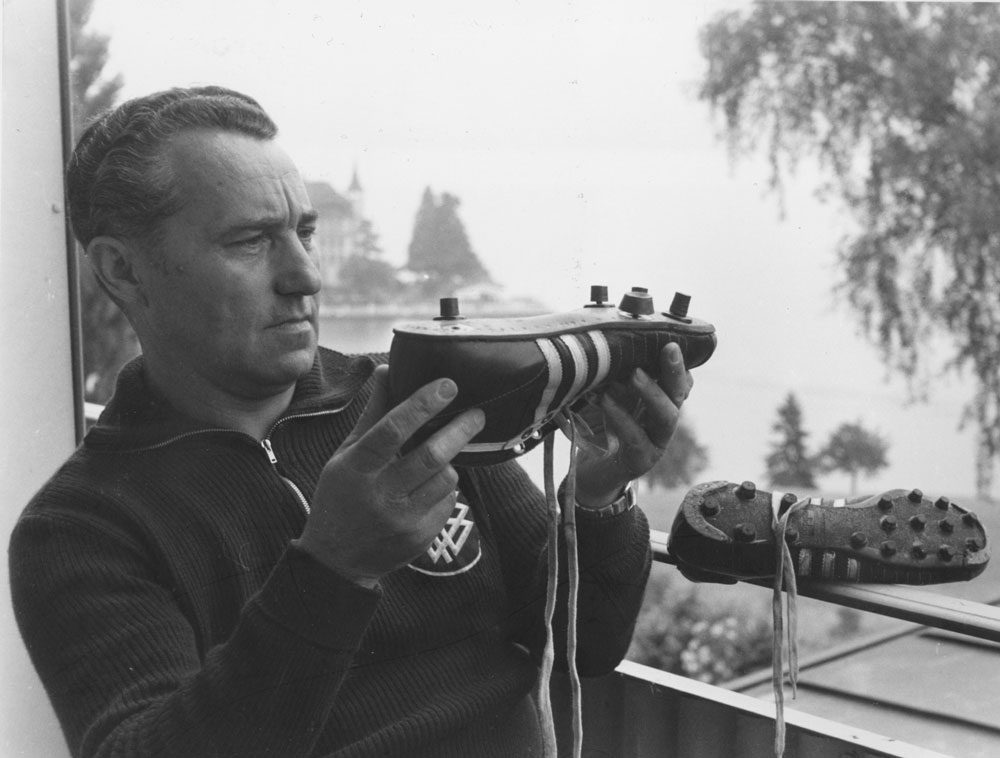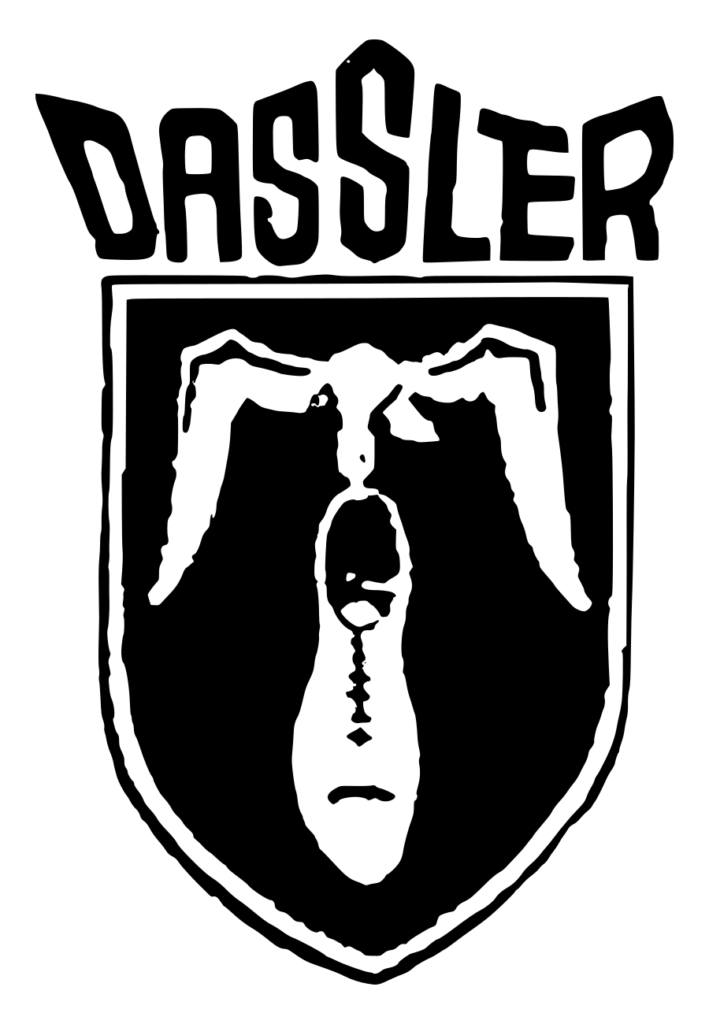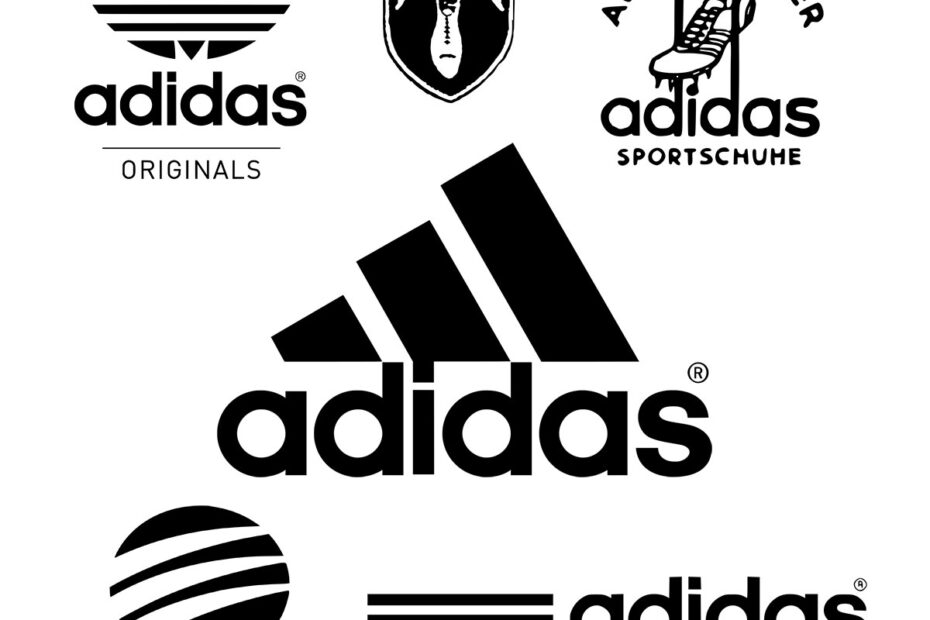Building an iconic brand is a long-distance race – who doesn’t recognize the Adidas logo?
Today, Adidas is one of the leading sportswear brands in the world; its logo is so identifiable that even fans of Nike and Puma recognize those three vertical lines instantly.
As the brand has evolved, the Adidas logo has gone through multiple redesigns. From the Olympic stage to the streetwear style adored by celebrities, the Adidas logo is a sign of quality and style.
Here’s a look at how the Adidas logo has evolved from its inception to the current brand that has come to define the global sportswear market.
A brief history of the Adidas brand

For many, the origins of Adidas may involve a bit of controversy: the company’s founder, Adolf Dassler, fought on the side of the Germans in World War I and joined the Nazi party in World War II
Don't miss our ultimate guide on graphic design!
Discover the best online courses, master's degrees, and university programs for a successful career in design with our "Ultimate Guide to Studying Graphic Design: The Best Options for a Successful Career". Shape your future in the creative industry today.View Post Read Later
After returning from fighting in World War I, Dassler began working in the manufacture of athletic shoes in his mother’s kitchen
At first, he was joined by his younger brother Rudolf, but after a falling out, Rudolf left the company and founded a company that would later become one of Adidas’ bitter rivals: Puma.
Adidas – then Dassler Shoes – got its first big break when Adolf went to the 1936 Summer Olympics with a suitcase full of cleats and convinced sprinter Jesse Owens to wear them in competition. Jesse Owens became the first African-American to receive sponsorship at the Olympics, and the popularity of Dassler Shoes soared.
In 1947, Adolf changed the name of his company to Adidas, after his nickname “Adi”. He retained control of the company until 1987, when it was sold to a French investor named Bernard Tapie. Tapie increased production of Adidas shoes, but unable to pay the interest on the loan he used to buy the company, Tapie sold Adidas to Robert Louis-Dreyfus.
Adidas changed hands a few more times in the following years, and gradually grew in success. Today, Adidas supplies apparel for the NBA, NFL and other sports, and in 2016 the company had a turnover of 19.3 billion euros
Along the way, Adidas has leveraged clever marketing and the popularity of their designs to achieve such success, and at the forefront of those designs is the recognizable Adidas logo, a logo they bought for the equivalent of what today would be €1,600 and two bottles of whiskey.
History of the Adidas logo

The Adidas logo has long been famous for its three stripes. However, it was not the first company to use the design.
The original owner of the logo was Karhu Sports. However, Karhu Sports was badly affected by World War II and, lacking capital, the owner agreed to sell Adidas the trademark of its logo for what today would be the equivalent of 1600 euros and two bottles of whiskey.
In 1971, the company unveiled the three-striped Adidas logo in a shape that resembled a leaf called a “trefoil”. This version was later replaced by the current triangle-shaped logo, although the trefoil logo can still be found on some Adidas products.
What is the significance of the Adidas logo?
Even before Adidas bought the trefoil logo from Karhu Sports, it added three stripes to all its products, and referred to itself as the “three-stripe company”. These three stripes were intended to convey the company’s diversity and international appeal by symbolizing the three major land masses where Adidas shoes were sold: North America, Europe and Asia.
Adidas added even more meaning and symbolism to its latest logo by turning it into a triangle that looks like a mountain leaning upward. This mountain symbolizes overcoming challenges, a popular theme for the athletes to whom Adidas sells its apparel.
Adidas has also chosen to put its company name in lowercase letters in its logo. This choice represents the casual and informal nature of the Adidas brand.
Finally, since the Adidas logo does not have a set color scheme, Adidas is free to alter the color of the logo in any way it sees fit to complement the design of the clothing on which it is placed.
The evolution of the Adidas logo
The company’s look and branding have changed a lot over the past century. In the mid-20th century, the Adidas logo was beginning to take shape with an identity similar to the current one.
Early brand logos

In 1924, athletic footwear was already booming. The Dassler brothers were selling 200,000 pairs a year with the Dassler logo. The original brand featured a bird carrying a lightweight shoe inside a shield.
The brothers parted ways in 1947 after their relationship soured. Rudolf founded Ruda (later renamed Puma) and Adolf registered Adidas. Both subsidiaries were named with acronyms combining the letters of their first and last names (Adi was a nickname for Adolf).

The first change to the Adidas logo, in 1949, replaced the name Dassler with Adolf Dassler. The sneaker is more detailed with spikes and the three stripes.
The iconic three-stripe brand was acquired by Adolf Dassler in the 1940s from Finnish shoe manufacturer Karhu Sports. The owner had money problems due to World War II and sold it to Adolf for, as mentioned above, two bottles of whiskey and the equivalent of 1600 euros today
In 1950, the only thing that remained of the previous logo was the typeface.
1971 The three-leaf or “trefoil” logo

In 1971, the company started manufacturing clothing, so it changed the shape of its logo to the now iconic trefoil. This trefoil logo is made up of three soccer shapes arranged so that the bottom part was curved. This 1970s version is now used by Adida’s Originals casual clothing line
The shamrock logo was intended to show the diversity of the products while still incorporating the three iconic lines for which the brand was quickly becoming known. The three leaves represent North America, Europe and Asia, the three continents where Adidas sneakers were sold.
Adidas was no longer relegated to athletes. This particular logo helped the brand to become part of pop culture, and to be worn by great bands such as The Doors, The Sex Pistols, Bob Marley and David Bowie, among others.
1991 The three bands or “mountain” logo

In the 1990s, the logo changed to another iconic version of the trio of lines now used for Performance products. The stripes previously used were changed to a slight angle, representing how they looked on sneakers. The three stripes were arranged in a mountain-shaped icon representing an obstacle to overcome.
2002: The Adidas Neo logo

In 2002, the stripes were contained in a circle, with the appearance of an animal’s paw or three paths leading into the background. Here, the stripes take on a stylized look, with smaller ends and a slight arc to the right side. At this point, the logo remains very flat and the typeface remains the same for the logotype. This logo now represents the Adidas Style product lines.
2005 Back to simplicity

The three stripes logo is a timeless callback to the simplicity of the three stripes that made the brand so easy to identify. The logo is general enough to encompass all areas of the brand, while maintaining the overall aesthetic of the company.
What does Adidas use each of its logos for?
Since its creation, the Adidas logo has undergone a great transformation. What’s interesting is that Adidas has been very smart about retaining and recycling previous versions of its logo creations.
In fact, the four current logos are used for different product lines and collections. The trefoil logo, for example, is used for casual streetwear, while the standard logo is used for Adidas’ high-performance line.
Three stripes: Sports line
The sports and performance apparel line uses the three stripes on the sides of the pants, the shoulders of the T-shirts and the sides of the sneakers. This is the most traditional form of the company’s logo, dating back to the original three-stripe branding that was acquired in the 1940s.
Adidas Original’s Trefoil : Streetwear and casualwear

The Trefoil’s comeback is one that has become popular with people completely outside of the sports scene. From big name musicians taking center stage to influencers, the Adidas lifestyle brand is a popular fashion line.
The products in these lines are more expensive and are not designed for athleticism, although the clothing still has an athleisure style. Celebrities such as Kanye West, Pharrell Williams and many others have helped make this line more popular than ever.
The mountain: the standard Adidas logo
The standard logo features a mountain, which represents the challenges athletes face and the goals they must achieve. Products in this line range from sports jerseys and sweatpants to cleated boots and more.
Neo-Circle: Brand collaborations
The circle logo appears in Adidas collaborations. This circle logo still carries the three stripes, but offers a different look to symbolize an everyday clothing line that is no longer focused on practical apparel.
What does the Adidas brand logo teach us about the importance of brand image?

Clothing companies live and die by the popularity of their design. Not only do they need their design to be appealing to customers, but they also need it to be immediately recognizable for the most important aspects of their marketing strategy to work.
For example, Adidas pays large amounts of money for its shoes to be worn by professional athletes in the NBA and elsewhere. The goal is for people to see those athletes wearing those shoes and be encouraged to buy them
However, when an NBA basketball player wears Adidas shoes on the court, there is no advertising that he or she is wearing them other than a prominent logo on the shoe. Therefore, Adidas is counting on people being able to recognize the logo in an instant for these promotions to work.
Fortunately, the Adidas logo is instantly recognizable. It’s a simple design that has changed very little over the years and doesn’t rely on hard-to-see text to make it recognizable.
While there’s no doubt that people buy Adidas clothing for its quality, the Adidas logo remains the company’s main selling point. All of their clothing carries the iconic Adidas logo in one form or another, making the logo the main design element of their products
Best of all, Adidas has managed to tie a message to its logo. When people see Adidas apparel or see someone wearing it, they immediately associate the apparel with quality and athleticism. It is this association that keeps many customers coming back to Adidas time and time again.
While large, quality logos are important for any company, they are vital for companies like Adidas and Nike, which base their entire marketing strategy on their logo. Given the company’s international success, Adidas is a great example of how successful a logo can be when done right.
Adidas logo in PNG format
Here you have the different Adidas brand logos in PNG format in case you need to use them in your projects (always remembering that Adidas is a protected trademark subject to copyright)
To download any of the Adidas logos featured in this article, right click on the button, save image as and you can save these Adidas logo images in PNG format


